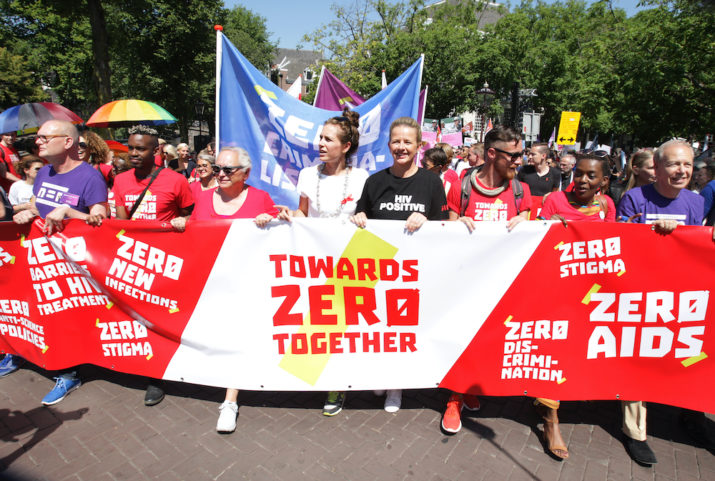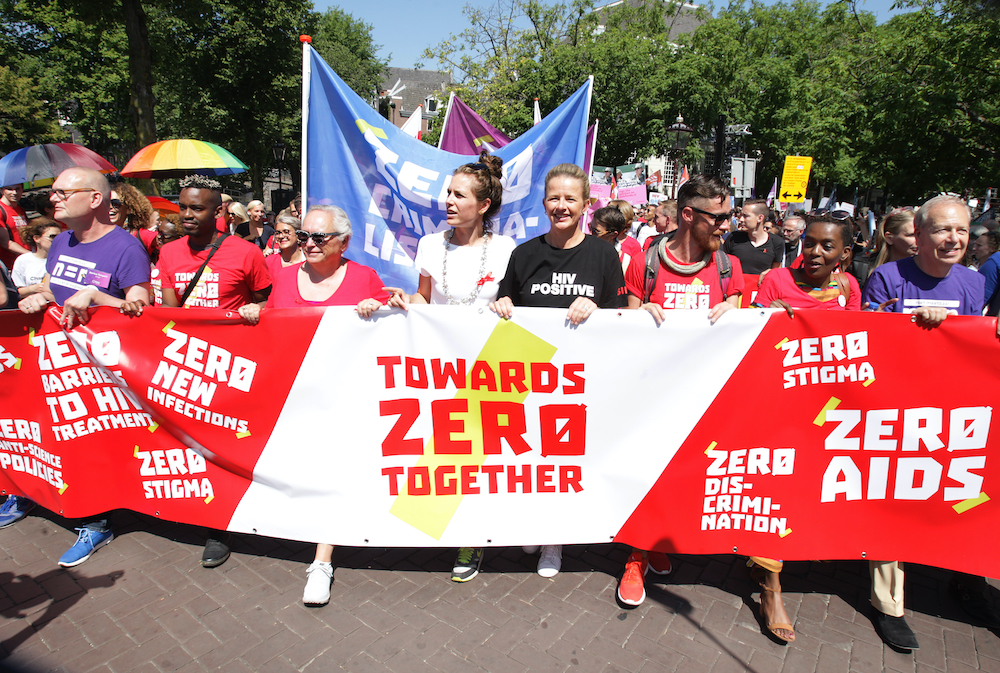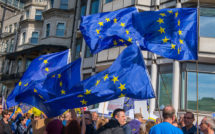

This is part of our special feature, Imagining, Thinking, and Teaching Europe.
In 1932, French scientist Charles Nicolle wrote:
If human civilization lasts, if it continues to spread, infectious diseases will increase in number in every region of the globe. Exchanges and migration will bring the human and animal diseases of all regions to every country. The work is ready well advanced; its future is assured.[1]
Indeed, as Nicolle (winner of the Nobel prize for his work on typhus) predicted, new viruses have had a profound effect on the ways humans relate to other humans globally, and have come to both affect local, national, and transnational governmental policy and politics. How democracies respond to health crises, seeing who is taken care of and who is not, is indicative of the health of those democracies themselves.
A chronic condition of history left undone
The immense project of the history of HIV/AIDS in Europe has largely been unwritten. While attempts have been made to make sense of the historical impact of the virus in Western Europe, most transnational, comparative studies were done in the midst of the crisis with the goal of informing policy, and before effective treatment of HIV/AIDS became widely available.[2] These studies lacked the perspective time provides. For instance, in 1992, David Kirp and Ronald Bayer edited a study of eleven countries, discussing one aspect of the AIDS crisis in each country. The study called Spain a country in “denial,” while lauding progressive treatment programs in the Netherlands and Denmark.[3] However, Spanish scientists were actually among the more prolific researchers in Europe, and Spanish activists were working with colleagues in the Netherlands—a European hub because of its strong funding of health care and research, as well as its progressive sex education programs. Another edited book, AIDS in Europe, published in 2000, was written primarily by sociologists and practitioners, without enough historical training or distance from the crisis to be considered a sufficient historical study of the disease in Europe.[4] In many ways, it is more of a primary source showing what were the contemporary understandings of the crisis at the end of the 1990s by scientists and social scientists than a historical work. While there are several books by mostly literary scholars that look at representations of AIDS in television, film, and photography in individual European countries, there is not a comprehensive, transnational study of HIV/AIDS in Western Europe by an historian.[5] Such a history would not only tell the history of networked European communities working together, but also would show how that collaboration demonstrated a need for what the type of large-scale research project coordination that the European Union would later undertake. Just as importantly, such work could also teach us lessons to be learned when such coordination did not happen, or fell apart.
While much excellent work by historians of the United States and the developing world is underway, the history of HIV/AIDS in individual European countries has been much slower. Virginia Berridge’s AIDS in the UK: The Making of Policy, 1981-1994, published in 1996, while an excellent model, is barely sufficient.[6] Some more recent national histories are starting to appear, like Action = Vie: A History of AIDS Activism and Gay Politics in France, by Christophe Broqua.[7] While an excellent book, it still presents only one case study of one country. While we need more local and national histories, we also need transnational histories that reflect how the shift from siloed nation-state histories to what became the EU affected the crisis and vice versa. These do not have to be mutually exclusive. The creation of the EU matters immensely to the history of AIDS. Moreover, histories that weave together a multitude of narratives would be particularly useful to understand alternative paths—and perhaps helpful in spurring new questions when considering local studies. Today, nearly forty years after the start of the AIDS crisis, we have the opportunity to begin the process of better grasping what that meant across Europe. By better understanding the European case we will have something with which to contrast the US case, potentially creating not only new discourses, but also new insights into both cases.
From dictatorship to HIV/AIDS: The Spanish story
My research on the HIV/AIDS crisis spins off of my studies into the libertine youth culture that grew up in the aftermath of the dictatorship of Francisco Franco in Spain. Beginning before the dictator’s death in 1975, a subversive youth culture—an intersection of punk, new wave and queer culture—the so-called “Movida madrileña,” created a vibrant underground scene that challenged the fascism of the dictatorship and helped pave the way to create a more pluralistic country. This counterculture was immortalized in the oeuvre of Oscar-winning queer Spanish director Pedro Almodóvar, whose films, such as Todo sobre me madre, often touch on themes related to HIV/AIDS. As seen in his work, participants of the Movida partook in psychedelics, heroin, cocaine, and had lots of unprotected sex.[8] Spain reached what is estimated as the highest heroin use in Europe by the late 1970s. Concretely, by 1984 an estimated .5% of Spaniards had used the drug. By 1994, that number reached .8 percent.[9] At the same time, queer and non-queer people alike started to take advantage of the break from the fascistic National-Catholic mores that had dominated the country since the end of the Spanish Civil War in 1939. In effect, the country transitioned out of fascism, both culturally and bureaucratically, vis-à-vis sex and injection drugs, just as the AIDS crisis arrived in the 1980s. Drug culture had become so normalized that in 1984, Madrid’s mayor, Enrique Tierno Galván, a socialist antifascist former professor who was born in 1918, encouraged young people to partake in sex, drugs, and rock and roll as a sort of enema to Francoism.[10] By the late 1980s, some doctors in Madrid have described to me that half of their hospital beds were filled with people diagnosed with HIV/AIDS.
Over the course of the last three years, I have conducted dozens of oral histories with researchers, doctors, survivors, bureaucrats, and journalists, and worked in eighteen archives. As a forewarning, there is no way to distill that work into a single essay, nor is there a single case study that could encapsulate it. When I started this project, I thought the focus would just be Madrid, but as I spoke to my interviewees and dug into the archives, I found that the story could not be told as a Madrid story alone. Advocates and educators in Madrid were organizing with people in Amsterdam who had learned their techniques on teaching sexual education by having worked with sex workers in the 1970s in that city’s red-light district—of which there is also not enough written. Spanish punks were going back and forth to London and New York to see shows and to “tear it up” and often came back infected. Spanish researchers were participating in global networks, creating transatlantic and trans-European organizations, and medical doctors were quitting their jobs at hospitals to enter PhD programs at the Pascal Institute in Paris to learn the latest research and treatment techniques—coming back to Spain to establish their own labs. Beginning in the 1980s, many HIV/AIDS researchers were using new computer technology that allowed for nearly instantaneous sharing of information—a precursor of the digital age that came on-line in the 1990s. Spanish activists learned from their parallels in New York, San Francisco, London, Paris, Germany, and the Netherlands. For its part, Spain was one of the countries where the double therapy treatment for HIV/AIDS was first tested in the 1990s before the more successful triple therapy was developed in 1996. Today, researchers have even identified a Spanish family with a mutation that makes them immune to HIV—the basis of much emerging scientific research.
Shifting grounds: Towards a comparative history
Given that studying Spain alone no longer felt adequate, I decided to find a way to determine which countries would be best to study in addition to Spain. Zooming out, I decided investigate which countries were most fruitful in research production during the 1980s. Scientific research provides a vast wealth of primary sources that can help piece together the history of HIV/AIDS. I recruited Daniel Stein, a biologist who was working on his Master’s in Biology and Nantotechnology at Harvard when I was teaching there. We created a comprehensive study of medical literature on HIV/AIDS treatment and innovations during the first decade of the crisis, creating a database with more than 1,400 documented peer-reviewed articles related to HIV/AIDS research published by Western European researchers from 1980-1989. This database codes author, title, topic, research funding source if listed, and the country/countries of origin of those articles, giving a vivid picture of research done in the 1980s in Austria, Belgium, Denmark, Finland, France, Greece, Ireland, Italy, the Netherlands, Norway, Poland, Portugal, Spain, Sweden, Switzerland, and the United Kingdom. I intentionally left out East and West Germany from this survey due to the additional complications given the context of the Cold War, which have been explored in Renilde Loeckx’s Cold War Triangle: How Scientists in East and West Tamed HIV.[11] I used this database as a guide to determine the most relevant archives containing primary source materials to investigate. Based on that database, most HIV/AIDS research produced in the period came from France, Italy, Belgium, followed by the Netherlands, Switzerland, and Spain.
The crisis played out very differently in Western Europe when compared with the US. And even then, it was varied amongst European countries, and not just in the amount of research produced. For example, at the beginning of the crisis, the most significantly affected groups in Southern Europe were drug users and migrants, and, only later, queer communities. In countries where new socialized health care systems were coming on-line, such as Spain, bureaucrats and politicians often found themselves asking the simple question of “if we are going to have to pay for treatment regardless, might we just as well put money into funding research?” Moreover, the crisis was often used as a rationale to motivate more cooperation amongst European countries and to force pharmaceutical companies to contribute to state-funded scientific research. Spain, for example, by the early 1990s, created a system that required international pharmaceutical companies wishing to sell their drugs in the country to pay a percentage of their profits to the state, which were designated to research groups for HIV/AIDS research. In 1993, the United Kingdom had thirty-two centers, the Netherlands had twenty-seven, France had twenty-one, Belgium nineteen, Germany seventeen, Spain fifteen, and Portugal eight. I have documented a total of 249 NGOs and state-funded organizations across Europe that treated people with HIV/AIDS. By focusing on a local and comparative model we can attempt to value systemic and particular visions.[12]
Europe in crisis
The early HIV/AIDS crisis consisted of much misinformation, underreporting, and even maliciousness amongst the scientific community—to the detriment of research. HIV was first identified and isolated in 1983 by Françoise Barré-Sinoussi, working with Luc Montagnier’s research group, at the virus oncology unit of the Pasteur Institute in Paris. The group used the lymph nodes of a “homosexual man with swollen lymph glands” to identify the infection. An American scientist, Robert Gallo, working with the US-based National Institutes of Health, initially also claimed the discovery, eventually admitting Montagnier’s team had initially made the identification.[13] [14] Whereas scientists like Gallo more obviously sought fame and funding, many European researchers were trying to find ways to better collaborate. In 1984, already, the European Commission was making resolutions to determine the best strategy to address the new crisis.[15] One internal European Commission document from March 1989 estimated only 12,414 cases throughout Europe.[16]However, this data was probably grossly underestimated. In fact, by 1989, there were 11,250 cases in Madrid alone, according to statistics provided by José Verdejo Ortés, who has worked for decades as an epidemiologist for the Comunidad de Madrid in affiliation with the Instituto de Salud Carlos III. In 1991, in addition to earlier efforts, the European Commission began the “Euarope Against AIDS” program, enacting more explicit transnational collaboration.
As early as 1988, draft documents laying out the purpose for creating the European Union indicated a desire to create better social programs and connections amongst member countries. Despite many scholars today focusing on the creation of the EU as solely focused on free trade and a common currency, social issues were front and center as well. Addressing the HIV/AIDS crisis was considered a question of democracy-building. This is seen in a section, “Strengthening Democratic Legitimacy: Relations between Institutions and the People of Europe” in the draft EU documents, claiming “the Commission proposed that any increase in the Community’s powers should concentrate on social affairs, major infrastructure networks and the free movement of persons, all three having a bearing the optimum development of the single market.”[17] Social issues, networks, mobility, and money were considered in tantum. Following that statement, the document demonstrates how those mandates could work to address major public health issues, arguing “a legal basis should be provided to allow the Community to develop programmes to prevent and combat major threats to health such as cancer and Aids, as it has already done at the request of the European Council.”[18] At its foundation, the European Union project was meant to better equip European countries to take on the threats such as AIDS.
An example of how this cooperation was enacted is seen in how European countries learned to better address questions of sex education from the Netherlands, which had been engaged in sex workers outreach since the 1970s. The Netherlands also pioneered a needle exchange program for harm reduction and a government-funded “buddy” program to help those with HIV/AIDS to survive longer—paying a friend or family member to help care for a seropositive person and assist with everyday tasks. One Spanish activist, Maite Manzanera Rodríguez began as a volunteer answering information phone lines in 1990, eventually became the director of Madrid’s “Citizen Anti-AIDS Committee,” and later director general of Foundation for the Investigation and Prevention of AIDS in Spain. She often collaborated with colleagues in Belgium, Germany, and the Netherlands—even modelling many efforts after AIDS Mobility in the Netherlands, which particularly targeted migrant communities.[19] [20] Such efforts at cooperation further democratized information and demonstrated seropositive individuals’ value as a citizen both locally and within the broader European Community.
However, despite these beneficial programs, the European Community was far from a utopian wonderland for people diagnosed with HIV/AIDS; patients still encountered prejudices in hospitals and in society more broadly. Some Spanish doctors would put a “red dot” on patients’ charts, marking them as lost causes. Discrimination also occurred in some of the scientific literature, particularly in Belgian scientists’ assumptions about black, Congolese migrants. Indeed, these attitudes influenced who would later be eligible for socialized health care. Today, sixteen European countries (including Spain and Sweden) do not provide antiretroviral treatment to undocumented migrants living with HIV.[21] Still, when taken as a whole, Europe was quite a different case compared to the US crisis. Indeed, by studying the AIDS crisis we can also see the limits of who can be accepted as European or as citizen.
A question of scale
To date, most scholarship on HIV/AIDS has addressed the history and social, political, and cultural impact of HIV/AIDS in the United States. Whereas US scholarship on HIV/AIDS initially focused mostly on gay men, now, more and more it has shifted its focus to other queer people, sex workers, drug users, and people of color. European historians of HIV/AIDS must learn those lessons from US historians, but also include its own particularities, considering the cultural perception of African immigrants and the integration of people of color into European society.
One of the challenges to consider in the study of HIV/AIDS in Europe that is particularly difficult is the question of scale. The simple fact is that with the very little exception most research on the subject of the HIV/AIDS crisis in Europe has been hyper localized. Many attempts to look more systematically at the crisis get lost in bureaucratic apparatuses and the like, which is not what I am advocating for. But it is also not sufficient that many historical studies of HIV/AIDS fail to examine how HIV/AIDS was simultaneously addressed transnationally and locally, ignoring the interconnected nature of the crisis.[22] Moreover, we absolutely need to put the people who contracted HIV/AIDS at the center of our narratives. This matters profoundly because any history of HIV/AIDS reflects the flaws and triumphs of democratic processes in both the ability for people to advocate for themselves and for democratic governments to react—as the draft documents of the EU clearly demonstrate.
Thousands of documents from the World Health Organization show the initial collaborations between bureaucrats and scientists in and across Europe and Africa. Should Africa be part of the European history too? How do we assess the impacts of colonization and the post-colonial period if that is the case? We are but at the beginning of this immense project, and like those researchers who first started their research into an unknown disease, we must collaborate with one another to demonstrate not only the importance of telling the stories of queer and marginalized people, but of the significance of collaborative research, and of imagining ourselves as part of a larger community.
Today, the COVID-19 crisis threatens Europe and the globe. Thus far, Europe has responded with the suspension of decades of open borders and movement. Debates about how to fund relief efforts have deepened fissures already cracking under the pressure of Brexit. While one health crisis, HIV/AIDS, helped bring Europeans together—to see the most vulnerable—this new crisis threatens to isolate individuals and nations. Where does one start to address the problem? At the local level or the transnational level? As the HIV/AIDS crisis taught us, all fronts must be fought simultaneously.
Louie Dean Valencia-García is an Assistant Professor of Digital History at Texas State University. He is the author of Antiauthoritarian Youth Culture in Francoist Spain: Clashing with Fascism (Bloomsbury Academic, 2018) and the editor of Far-Right Revisionism and the End of History: Alt/Histories (Routledge, 2020). He has been a Lecturer on History and Literature at Harvard University, is a Research Editor of EuropeNow and is co-chair of the Council for European Studies’ Critical European Studies Research Network. This research is supported by the American Council of Learned Societies. He has held fellowships from the Andrew W. Mellon Foundation, the United States Library of Congress, the Humanities, Arts, Science and Technology Alliance and Collaboratory, and the Spanish Ministry of Education, Culture and Sport.
References:
[1] Luc Montagnier, Virus: The Co-Discoverer of HIV Tracks Its Rampage and Charts the Future (New York: W.W. Norton, 2000), 9.
[2] Sandro Cattacin, Christine Panchaud, and Véronique Tattini, Les politiques de lutte contre le VIH/sida en Europe de l’Ouest: du risque à la normalisation, Collection Logiques politiques (Paris: L’Harmattan, 1997); Virginia Berridge and Philip Strong, eds., AIDS and Contemporary History, Cambridge History of Medicine (Cambridge: Cambridge Univ. Press, 2002); Philip Gatter, Identity and sexuality: AIDS in Britain in the 1990s (London: Cassell, 1999).
[3] David L. Kirp and Ronald Bayer, eds., AIDS in the Industrialized Democracies: Passions, Politics, and Policies (New Brunswick, N.J: Rutgers University Press, 1992).
[4] J.P. Moatti, ed., AIDS in Europe: New Challenges for the Social Sciences, Social Aspects of AIDS (London: Routledge, 2000).
[5] Douglas Crimp and Leo Bersani, eds., AIDS: Cultural Analysis, Cultural Activism (Cambridge, Mass: MIT Press, 1988); Kaye Wellings and Becky Field, Stopping AIDS: AIDS/HIV Education and the Mass Media in Europe (London: Longman, 1996); Berridge and Strong, AIDS and Contemporary History. Also: Jean-Pierre Boulé, HIV Stories: The Archaeology of AIDS Writing in France, 1985-1988 (Liverpool: Liverpool University Press, 2002).
[6] Virginia Berridge, AIDS in the UK: The Making of a Policy, 1981-1994 (Oxford: Oxford University Press, 1996).
[7] Christophe Broqua, Action=vie: A History of AIDS Activism and Gay Politics in France (Philadelphia: Temple University Press, 2020).
[8] Louie Dean Valencia-García, Antiauthoritarian Youth Culture in Francoist Spain: Clashing with Fascism (London: Bloomsbury Academic, 2018).
[9] See: Nacho Carretero, ‘El Misterio el regreso de la heroína’, El País, 26 February 2018, https://elpais.com/politica/2018/02/24/actualidad/1519473378_739514.html; Ismael Fuente Lafuente, ‘El movimiento del “caballo”’, El País, 14 April 1984.
[10] Valencia-García, Antiauthoritarian Youth Culture in Francoist Spain: Clashing with Fascism.
[11] Renilde Loeckx, Cold War Triangle: How Scientists in East and West Tamed HIV (Leuven, Belgium: Lipsius Leuven, 2017).
[12] H.M Stroomer, Who Is Who: An Overview of Organisations Working in the Field of Aids Prevention and Youth in Europe (Utrecht: Dutch Centre for Health Promotion and Health Education, 1993).
[13] John Crewdson, ‘Gallo Admits French Discovered AIDS Virus’, Chicago Tribune, 31 May 1991, https://www.chicagotribune.com/news/ct-xpm-1991-05-30-9102180196-story.html.
[14] Montagnier, Virus.
[15] See: the resolutions of the European Parliament on AIDS (OJ C 46, 20.2.1984, OJ C88, 14.4.1986.)
[16] EC Library, A 2-34/89/Part B.
[17] “Commission Opinion of 21 October 1990 of the Proposal for amendment of the treaty establishing the European Economic Community with a view to political union,” European Commission Library, Com (90)600.
[18] Ibid.
[19] Manzanera Rodríguez, María Teresa (Maite). Personal Interview. Madrid, 14 July 2019.
[20] See: Loes Singels, “AIDS Prevention for Migrants in the Netherlands,” in Theo Sandfort, ed., The Dutch Response to HIV: Pragmatism and Consensus, Social Aspects of AIDS (London ; Bristol, Pa: UCL Press, 1998).
[21] UNAIDS, ed., The Gap Report (Joint United Nations Programme on HIV/AIDS (UNAIDS), 2014).
[22] As seen in J.P. Moatti, ed., AIDS in Europe: New Challenges for the Social Sciences, Social Aspects of AIDS (London: Routledge, 2000). This study looks individually at countries, but not at connections between them.
Photo: Princess Mabel Van Orange of the Netherlands with activists taking part in the HIV and AIDS march “Towards Zero Together” in Amsterdam in 2018 | Shutterstock
Published on June 3, 2020.




